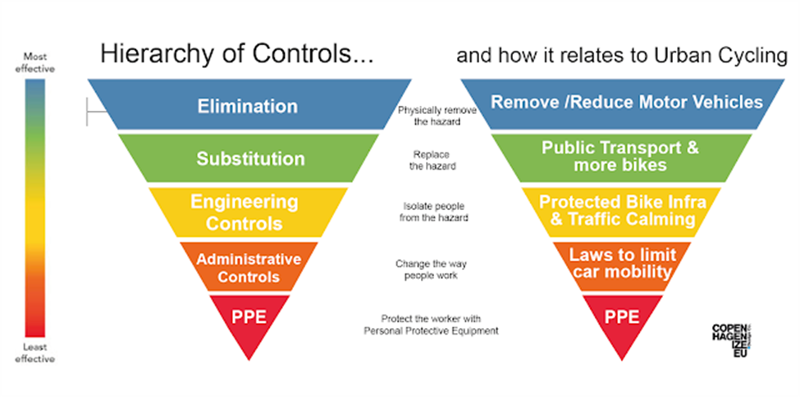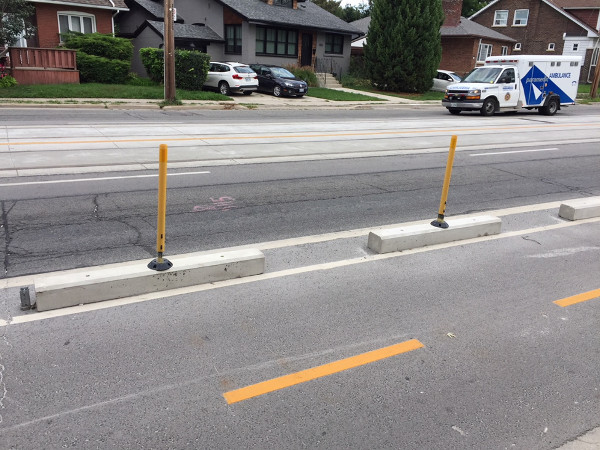We could have saved the life of Herman Ohrt by applying the Hierarchy of Controls to the design of our transportation system.
By Kevin Love
Published October 25, 2018
Herman Ohrt should be alive today. His death on August 17, 2018 was preventable. On that date, Mr. Ohrt was killed by the driver of a cement mixing truck while he was riding his bicycle south on Queen Street North at King Street West.

Looking south at King Street West from Queen Street North (RTH file photo)
Queen Street is a notoriously dangerous road, and has been for a long, long time. For an equally long time, Hamilton City Council has failed to take effective action to fix this dangerous street.
The latest ineffective action was to install "knockdown placards" at the pedestrian crossing at Queen and Herkimer. As the name suggests, these placards are designed to fall down and provide zero protection when struck by a motor vehicle operator.
It is truly frightening to see a photograph of the battered and damaged knockdown placard at the edge of the bicycle lane where it meets the pedestrian crossing. The damage to the placard as well as the motor vehicle tire marks in the bicycle lane make it crystal clear that this bicycle lane is a very, very dangerous place to ride a bike.

Damaged knockdown placard and motor vehicle tire marks in the bike lane at Queen and Herkimer

Same scene, different angle to better show the damaged bollard
So what needs to be done to provide real protection and real safety? Herman Ohrt himself knew what needed to be done. To quote from Ryan McGreal's article about his death:
As Herman-the-engineer would have put it, "You can't design a system with only one check valve," and the design of Queen Street leaves no room for error in a place where human beings are trying to live.
In other words, to make this street safe there needs to be multiple redundant levels of protection. Those levels of protection are laid out by the Hierarchy of Controls.
Anyone who has worked in one of Hamilton's factories and participated in industrial health and safety training in the workplace should be familiar with the Hierarchy of Controls. They are laid out at the bottom of page 11 of the Hazard Management Tool [PDF] published by the Ontario Workplace Safety and Insurance Board (WSIB).
Here is an explanation of how this Hierarchy of Controls applies to street safety, courtesy of the good folks at [Copenhagenize[(http://www.copenhagenize.com/2018/04/ghent-changing-whole-circulation-plan.html):

Hierarchy of Controls and how it relates to urban cycling (Image Credit: Copenhagenize)
Applying this Hierarchy of Controls to prevent more deaths like Herman Ohrt's results in the following:
In Hamilton, this means removing cut-through truck traffic from Hamilton. Instead, we can use a neighbourhood strategy to remove this truck traffic from city streets and require it to use the Highway 403/Lincoln Alexander Parkway/Red Hill Valley Parkway/Queen Elizabeth Way/Nikola Tesla Boulevard ring highway around Hamilton.
This means carrying cement (and other goods) by means other than heavy trucks. We don't know how far the particular cement truck driver was travelling who killed Herman Ohrt. But we do know that it is only because of the high government subsidies paid to trucking companies that a high volume of good is dangerously carried by trucks instead of safely carried by railways.
Damage to street surfaces goes up as the fourth power of vehicle axle weight. So a vehicle that weighs twice as much does 16 times as much damage, and a vehicle that weighs four times as much does 256 times as much damage to the street.
The overwhelming majority of road repair and maintenance dollars are an enormous subsidy to trucking companies, paid for by the property taxes of everyone else.

Pothole marked for filling (RTH file photo)
On the other hand, railway companies pay 100 percent of the repair and maintenance cost of their own track, railbed and signals. It is a testimony to the efficiency of railways that they can compete at all with the enormous subsidies provided to trucking companies.
Railways can only compete with this high level of government subsidy of trucking companies because of the very high efficiency of rail transport. Indeed, four truckloads of cement can be carried on only one railcar.
Removing the government subsidies of trucking companies and requiring them to pay the costs of the damage they do to our roads would result in a large volume of goods transportation to switch from dangerous trucks to much safer rail transportation.
Even after steps #1 and 2 are completed, there will still be a small amount of cement truck traffic from the railhead to local job sites. To protect people from this residual truck traffic, it is necessary to have protected cycling infrastructure. This means putting steel and concrete between human beings and motor vehicle operators.
Here are some recent photographs from Toronto, taken on Lakeshore Boulevard near Royal York Road.

Bicycle lanes protected by concrete curb with knockdown sticks on top

Bicycle lanes concrete protective barrier, lengthwise view

Bicycle lanes concrete protective barriers, side view
Let us look again at this article's first photographs of the intersection of Queen and Herkimer. Particularly the photo of the damage to the knockdown placard and motor vehicle tire tracks right in the bicycle lane.
Obviously, a high level of direct physical protection is necessary in this location to prevent death and injury. A good example of such protection would be to replace the knockdown placards with stout steel safety bollards protecting the bicycle lane through this intersection.
Below is a security camera video showing a real-life example of two people whose lives were saved by safety bollards protecting them from a drunk truck driver.
Shocking surveillance video shows a pickup truck barreling into the front of a donut shop at full speed, narrowly missing customers inside. The driver was arrested for driving under the influence. https://t.co/h3NUsdtpbG pic.twitter.com/hcRbZWKzo8
— ABC News (@ABC) June 10, 2018
Why don't we have the same level of safety at Queen and Herkimer? Or at Queen and King?
That is how we could have saved the life of Herman Ohrt: through multiply-redundant levels of protection.
The first level is to remove the hazard using a neighbourhood strategy that prevents rat-running cut-through motor vehicle traffic in the first place.
The second level is to substitute safe transportation of goods by railway instead of dangerous transportation of goods by truck.
And the third level is engineering controls in the form of stout steel and concrete barriers between dangerous motor vehicles and vulnerable human beings.
By Maggiem (registered) | Posted October 25, 2018 at 07:32:49
Hess Street is also becoming a “dangerous road” . Multiple transport trucks barrel down the street ignoring the speed bumps and the foundations of our homes shake to the core. These massive trucks travel on the street at all hours and their cargo is highly suspect. Flammable liquids, huge drums of oil. And the response from the city and police department? It’s legal. Hess and Queen streets at York Boulevard share an elementary school and my concern for the safety of our most vulnerable residents increases with every passing day. In this area of Hamilton, it is not “ a great place to raise a child”
Comment edited by Maggiem on 2018-10-25 07:36:54
By KevinLove (registered) | Posted October 25, 2018 at 22:58:38 in reply to Comment 124069
Many things used to be legal that are now forbidden by law. Asbestos, lead paint, beating children, sexual harassment, thalidomide, beating wives, lead pipes, smoking in bars and restaurants, etc, etc.
A proper neighbourhood traffic circulation plan would eliminate rat-running cut-through truck traffic through residential neighbourhoods.
You must be logged in to comment.
There are no upcoming events right now.
Why not post one?